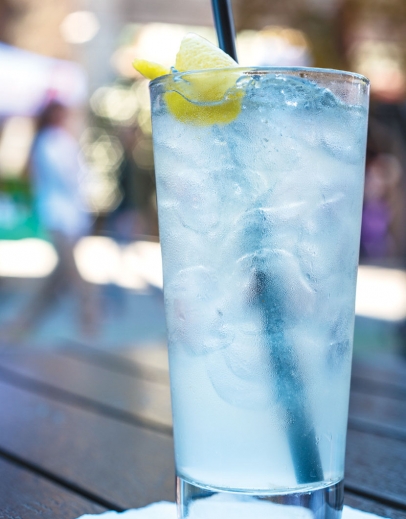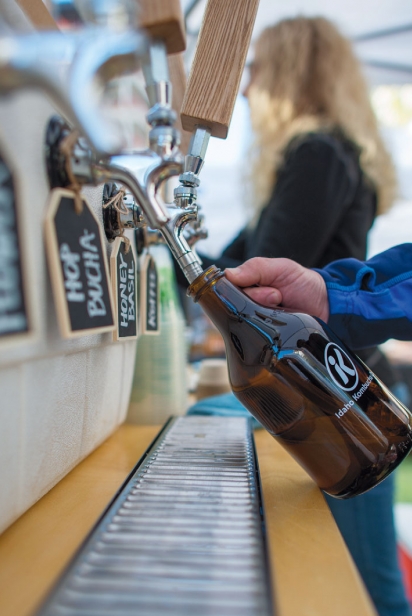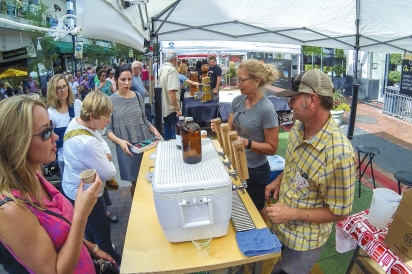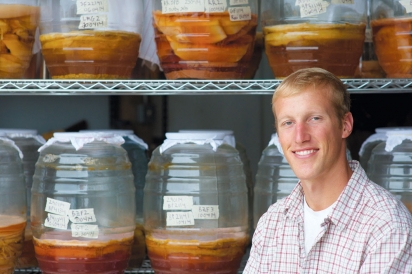Lightly Fizzy, Slightly Sour
The kombucha craze shows no signs of going flat
Making kombucha is a bit like taking care of a pet. Though the SCOBY (symbiotic colony of bacteria and yeast) might not be the most attractive creature you’ve ever seen, this gelatinous, yellowish disk is the workhorse of kombucha (pronounced kom-BOO-cha). Its job is to convert tea and sugar into a lightly fizzy, slightly sour drink.
According to Mike Landa of Idaho Kombucha, the SCOBY has to be fed, kept warm, needs to breathe, doesn’t like light and sometimes needs a bath. He stopped short of saying he takes it for a walk.
Landa started making kombucha 10 years ago and began producing it in a small commercial kitchen in Garden City in 2013.
“I needed a source of income, which will happen someday,” Landa laughed.
But that someday may come soon, as kombucha is continuing to gain popularity. According to market research firm SPINS, the beverage saw 29% combined growth across all channels from February 2013 to February 2014, and it shows no signs of slowing down. Hannah Crum, co-founder of Kombucha Brewers International, predicts sales will top $500 million in 2015.
“It’s a functional beverage,” Landa said. “In the grocery industry overall sales are flat. When you look at what is selling, organic and natural foods are climbing. Within that category are functional beverages, so [retailers] are dedicating more space to them—often premium real estate like an end aisle or by the cash registers.”
What is a functional beverage? According to The Medical Dictionary, it’s “A non-alcoholic drink that contains nontraditional ingredients, including herbs, vitamins, minerals, amino acids or added raw fruit or vegetable ingredients, which is claimed to provide specific health benefits beyond those of general nutrition.” The flavors often found in kombucha—everything from hibiscus to sage—can be infused in fermentation or added afterwards.
Many functional beverages also tout health benefits, although they’re not necessarily backed by the FDA. Kombucha claims include that it contains probiotics and enzymes, which aid digestion, and that it’s high in B vitamins. But healthiness aside, Landa said it all comes down to taste.
“I drink it because I like it. If you don’t like it, don’t drink it,” he said.
Though some claim kombucha is sour or vinegary, others insist it tastes herbaceous, floral or sweet, depending on what flavors have been added. And though tea is one of the main ingredients, the finished product retains none of that brewed flavor.
Where kombucha brewers got their first SCOBY is something they remember with the fondness of a first kiss. It’s also something that’s passed down like a family heirloom.
Mike Sommer of Purple Sage Brewing received his first SCOBY in the mail from his sister while he was working in Glacier National Park. He started making kombucha with wild herbs that he foraged—botanicals such as rosehip, bergamot and strawberry leaf.
When Sommer moved back to the the family farm in Middleton in 2009, he started producing kombucha commercially, which he sold at Boise Co-op and Capital City Public Market. Sommer took a break in 2013, but with a new commercial kitchen scheduled to be completed by the end of the year at Purple Sage Farms, he plans to get back in the bulk-brewing game soon. With a farm full of herbs, Sommer has no shortage of ideas when it comes to things he’ll make in the new kitchen—pesto, herbal teas, ready-to-eat salad greens and fermented vegetables. He also has plans to produce a hard kombucha. Since this will be an alcoholic beverage, Sommers is still researching what special licenses he’ll need, but he hopes to release this new item in the first half of 2016.
Gabe Yeamans of Boise Kombucha also got his start from a sibling. While Yeamans had been brewing kombucha for 10 years, it wasn’t until 2012 when his brother opened Hawaii Kombucha that he was inspired to go commercial.
“After visiting my brother and his brewery, I realized that there was a need for local kombucha in Boise and I was lucky enough to have a brother that could help me make that happen,” Yeamans said.
Starting Boise Kombucha was definitely a labor of love. Yeamans worked long nights after putting in full shifts at his day job and invested every penny he had. It took a year from the time he decided to go commercial until his first keg was sold at The Crux. Now Yeamans brews 140 gallons a month.
His current favorite flavor is a Jamaican rooibos made with red rooibos tea, licorice root, lemongrass and hibiscus flowers.
“It comes out bright red and has a refreshing sweet and spicy flavor to it,” Yeamans said. “Kombucha has that bubbly mouthfeel you get from soda and beer, making it the perfect alternative for people looking for something healthier.”
Though kombucha may be healthier, that doesn’t mean you can’t have some fun with it. When Kacey Montgomery of downtown Boise restaurant Juniper asked Landa: “Do you think we could make a cocktail using kombucha?” Landa was quick to answer, “Yes!” Juniper’s popular Lavender Lemonade kombucha cocktail was the result. For some, it takes adding a little hooch for them to try the ‘booch.
Healthy and boozy are two of Linda Whittig’s favorite food groups. Get more of both types of recipes at BistroOneSix.com.








